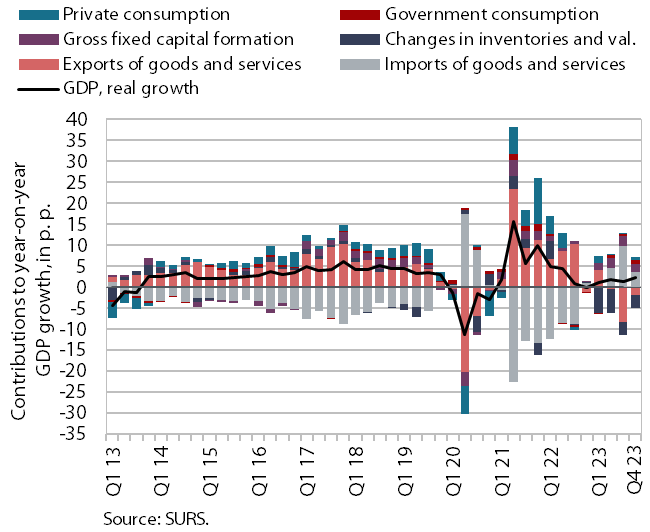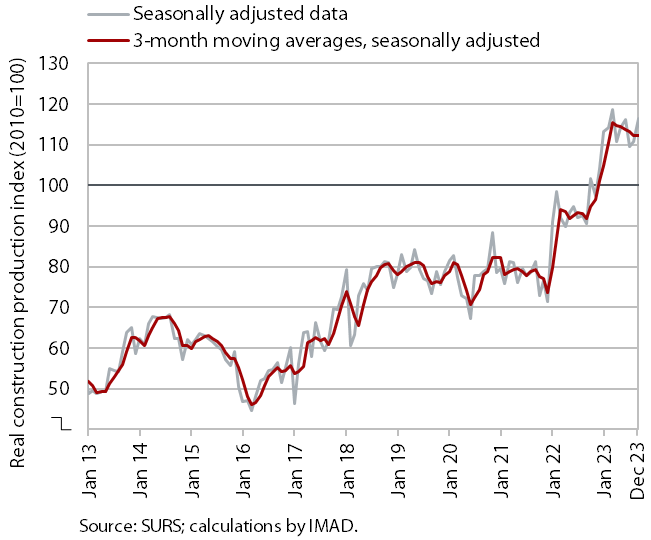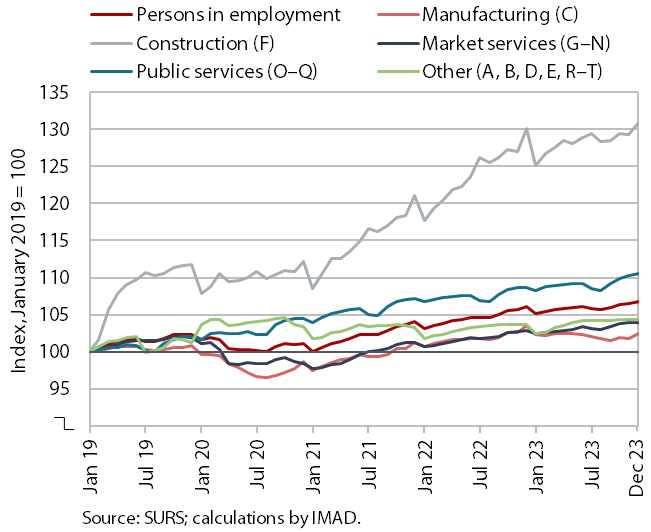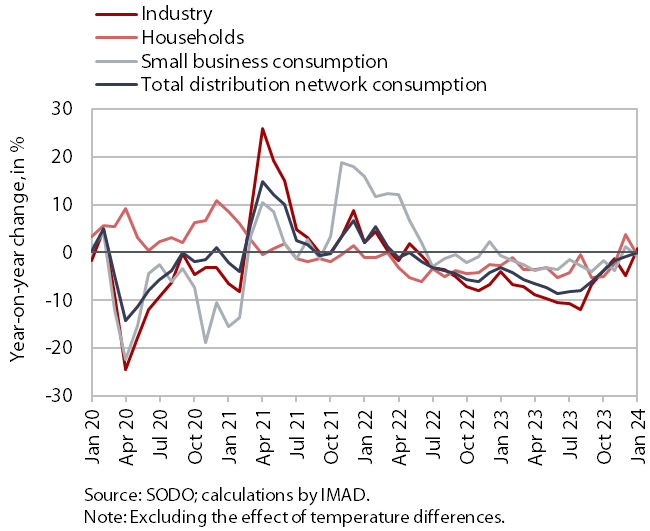Charts of the Week
Charts of the week from 12 to 16 February 2024: gross domestic product, current account of the balance of payments, activity in construction and other charts
GDP growth slowed to 1.6% last year. Investment growth was particularly high. Growth in government and also private consumption was higher than expected. Exports of goods and, even more so, imports of goods fell short of expectations. Last year, the trade balance made the largest contribution to the return to a high surplus in the current account of the balance of payments. Construction activity, which picked up in December, was on average around one-fifth higher year-on-year. Growth in the number of persons in employment slowed further in December. On average, their number rose by 1.3% last year compared to 2022. Electricity consumption in January was similar to a year ago, with the same number of working days and the low base effect.
Gross domestic product, Q4 2023

After stagnating in the third quarter of last year, GDP rose by 1.1% (seasonally adjusted) in the fourth quarter and was 2.2% higher year-on-year (not seasonally adjusted). The situation in the export-oriented part of the economy, which mostly lagged behind the year-ago level, improved slightly towards the end of the year. Domestic activity was stimulated by activities related to the flood recovery and the increased purchasing power of households. Growth in economic activity in 2023 as a whole was 1.6%, which is fully in line with expectations in our Autumn forecast. Growth in investment and construction activity was particularly high and growth in government consumption was also higher than expected. Private consumption growth was also slightly higher. Exports of goods, which decreased last year, were much lower than expected in the autumn. This was mainly due to the continued uncertainty in the international environment, a slowdown in activity in Slovenia’s main trading partners and a deterioration in competitiveness of Slovenian exporters due to increased cost pressures.
Current account of the balance of payments, December 2023

After a deficit in 2022, the current account of the balance of payments returned to a high surplus in 2023 (EUR 2.8 billion or 4.4% of GDP). This was mainly due to the trade balance, as the decline in real imports of goods was more pronounced than the decline in exports, and the terms of trade improved after two years of deterioration. According to our estimate, the quantity fluctuations contributed EUR 1.5 billion to the change in the nominal trade balance (EUR 2.6 billion) and the terms of trade EUR 1.1 billion. The growth of the services surplus continued, especially in trade in transport and construction services. The surplus increased also in the trade in knowledge-based services (telecommunications, computer and information, R&D services and financial services). The deficit in primary income was lower, mostly due to lower net outflows of income from equity capital (dividends and profits). In addition, revenue from Slovenian workers working abroad was higher than revenue from foreigners working in Slovenia. The lower secondary income deficit was arising from lower net outflows of private sector transfers (payments of non-life insurance premium).
Activity in construction, December 2023

According to data on the value of construction work put in place, construction activity increased in December 2023 and was also higher year-on-year. After a sharp rise in the value of construction put in place at the start of 2023, activity fluctuated sharply in the following months and was slightly lower in the fourth quarter than at the beginning of the year. The total value of construction put in place last year was 19% higher than one year earlier. In this comparison, activity was higher in all three segments covered by the statistics: in specialised construction by 31%, in civil engineering by 20% and in building construction by 11%.
Some other data, however, point to much lower growth in construction activity. According to VAT data, the activity of construction companies was 11% higher last year than a year earlier. Data on the value of industrial production in two activities traditionally strongly linked to construction also do not point to such high growth. Production in other mining and quarrying was 1% lower last year, while it was 10% lower in the manufacture of other non-metallic mineral products.
Number of persons in employment, December 2023

In December, the year-on-year growth in the number of employed persons slowed. The number of persons in employment was lower in manufacturing, where their number has declined since September (seasonally adjusted). The number of persons in employment also declined in construction, although it was still higher year-on-year. The year-on-year increase in the number of persons in employment was due to a higher number of employed foreign nationals, while the number of employed Slovenian citizens fell. The share of foreign citizens among all persons in employment was 15% in December, 0.8 p.p. higher than a year earlier. Activities with the largest shares were construction (49%), transportation and storage (33%) and administrative and support service activities (27%). In 2022 as a whole, the number of persons in employment was 1.3% higher than in 2022.
Electricity consumption by consumption group, January 2024

In January, electricity consumption in the distribution network was similar to a year ago. The year-on-year drop in total consumption has declined since mid-2023, partly due to the low base. With the same number of working days, industrial consumption in January was higher than in the same month last year (by 0.7%). Household consumption fell by 0.7% year-on-year, while small business consumption fell by 0.9% year-on-year.
